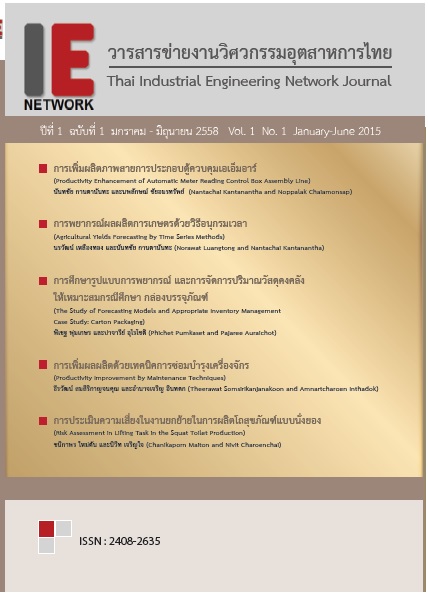Productivity Enhancement of Automatic Meter Reading Control Box Assembly Line
Main Article Content
Abstract
Currently, the problem of the of Automatic Meter Reading Control Box (AMR) assembly department of the case study company is the different workload in each workstation which results in high idle time of the workers. At the same time, the AMR assembly process is discontinuous and has high production cost. Therefore, this research intends to balance the AMR assembly line. The main objectives are to increase the labor productivity and reduce the production cost. The study begins from collecting data from the workers, determines the standard time and proposes five improvement guidelines based on the number of workers in the assembly line. The assembly line is balanced by Kilbridge & Wester method. Five proposed guidelines are simulated by Arena program. The simulation results show that the fifth improvement guideline delivers the best results according to the objectives. It has the highest labor productivity and lowest unit labor cost. The average labor productivity is 24.83 units per worker, increased by 63.36 percent and the unit labor cost is 12.08 baht, decreased by 38.80 percent. In addition, this guideline employs only six workers, decreased four workers from the current practice. It produces AMR 149 units, decreased by 1.97 percent. The average time is 3.11 minutes, increased by 2.64 percent. The assembly line efficiency is 94.17 percent, increased by 51.64 percent.
Article Details
บทความ ข้อมูล เนื้อหา รูปภาพ ฯลฯ ที่ได้รับการตีพิมพ์ในวารสารฯ ถือเป็นลิขสิทธิ์ของวารสารฯ หากบุคคลหรือหน่วยงานใดต้องการนำทั้งหมดหรือส่วนหนึ่งส่วนใดไปเผยแพร่ต่อหรือเพื่อกระทำการใดๆ จะได้รับอนุญาต แต่ห้ามนำไปใช้เพื่่อประโยชน์ทางธุรกิจ และห้ามดัดแปลง
References
[2] van Zelst, S., van Donselaar, K., Woensel, T., Broekmeulen, R. and Fransoo, J. 2009. Logistics drivers for shelf stacking in grocery retail stores: Potential for efficiency improvement. International Journal of Production Economics, 121: 620-632.
[3] บุษบา พฤกษาพันธุ์รัตน์. 2552. การวางแผนและควบคุมการผลิต. สานักพิมพ์ท้อป, กรุงเทพฯ.
[4] Chen, J.C., Chen, C.-C., Su, L.-H., Wu, H.-B. and Sun, C.-J. 2012. Assembly line balancing in garment industry. Expert Systems with Applications, 39: 10073-10081.
[5] Tuncel, G. and Topaloglu, S. 2013. Assembly line balancing with positional constraints, task assignment restrictions and station paralleling: A case in an electronics company. Computers and Industrial Engineering, 64: 602-609.
[6] Sternatz, J. 2014. Enhanced multi-Hoffmann heuristic for efficiently solving real-world assembly line balancing problems in automotive industry. European Journal of Operational Research, 235: 740-754.
[7] รุ่งรัตน์ ภิสัชเพ็ญ. 2553. คู่มือสร้างแบบจาลองด้วยโปรแกรม Arena ฉบับปรับปรุง. สานักพิมพ์ซีเอ็ดยูเคชั่น, กรุงเทพฯ.
[8] Ekren, B.Y. and Ornek, A.M. 2008. A simulation based experimental design to analyze factors affecting production flow time. Simulation Modelling Practice and Theory, 16: 278–293.
[9] Yun, W.Y., Lee, Y.M. and Choi, Y.S. 2011. Optimal inventory control of empty containers in inland transportation system. International Journal of Production Economics, 133: 451-457.


